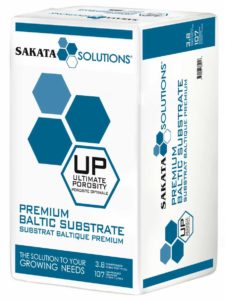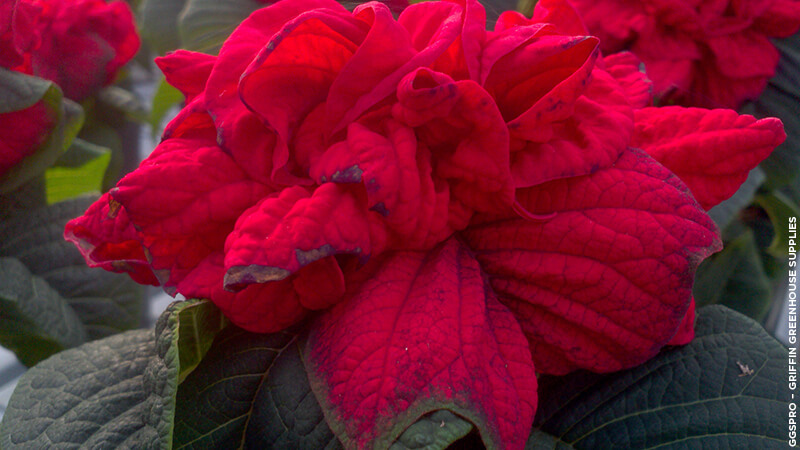Do Your Plants Have the Right Mix of Growing Media?
Healthy plant production starts with a healthy growing media mix and having the knowledge in place to help you choose the right mix for your crop can go a long way in affecting your bottom line.
Here are just a few of the trends driving today’s growing media market, including the key attributes growers are looking for, and how suppliers are becoming more innovative in the solutions they provide.
Digital Data Tools
Growers everywhere are looking for tools to help them make more informed decisions about plant production. Grodan, part of the Rockwool Group, is one company making this happen. Earlier this year, Grodan launched E-Gro, a software platform for data-driven precision growing designed to give growers smarter insights into the greenhouse, allowing them to fully optimize cultivation. Through the platform and an app, e-Gro supports a grower’s knowledge, experience, and growing strategy with insights and smart recommendations based on the root zone, climate, crop, and harvest data.
Breeders Get Into the Game
Plant breeders are always looking for ways to provide their grower customers with even more solutions, and one way to do this is to expand their offerings.
Earlier this year, Sakata Seed America formed a strategic alliance with major European substrate producer Floragard Vertriebs GmbH, which develops and manufactures premium potting soils and substrates, for exclusive distribution of substrates throughout North America. The deal allows Sakata to extend its genetics portfolio and provide growing solutions to its customers through exclusive distribution of premium Baltic peat moss and substrate product offerings designed specifically for North American growers.

Through its Sakata Solutions division, Sakata Seed America partnered with European substrate producer Floragard Vertriebs GmbH to provide a Baltic peat mix to its growers.
Photo courtesy of Sakata
According to Joe Cimino, Head of Sakata’s Ornamental and Solutions Division, the company recognized an opportunity to leverage its resources while offering an innovative solution to growers who may be frustrated with availability and quality issues when it comes to growing media.
“Sakata is a farming operation, and we operate our own greenhouses, which gives us the ability to trial material in real-world conditions as opposed to a structure attached to an office building,” Cimino says. “We use what we sell in our facilities, we know how it performs, and we are confident our material will perform at the highest level for our customers.”
A Clean Product
Providing a sterile media environment is critical when plants are still in the cutting stage, and steam sterilization of growing media has attracted grower interest for its low ecological impact. Nowadays, cutting farms such as Ethiopian Cutting (Syngenta), Florensis Ethiopia, Florensis Abyssinia, Dümmen Orange, Maranque Plants, and other cutting flower growers use steam sterilization for cleaning growing media in propagation or greenhouses, and it is considered an effective way to disinfect soilless media.
With steam sterilization, induced hot steam destroys soilborne pathogens to a level that causes protein coagulation or enzyme inactivation and physically degenerates their cell structure. Soil lethargy can also be cured through the activation of chemicals, and blocked nutritive substances are tapped and made available for plants. Steam sterilization leads to a better starting position, quicker growth, and improved resistance against disease and pests.
Steam can also be used to disinfest soilless media such as red ash, perlite, peat, and compost.
Roadmap to Sustainability
In Europe, the Growing Media Association (GMA), a group of manufacturers and suppliers producing more than 90% of growing media used in domestic and commercial sectors in the United Kingdom, is making progress in its development of a sustainability roadmap. One recent initiative is the Responsible Sourcing Guide, which will allow all growing media ingredients to be consistently labeled. The guide uses seven criteria for indicating environmental performance for growing media: energy use, water use, social compliance, habitat and biodiversity, pollution, renewability, and resource-use efficiency.
This approach will enable each ingredient to be scored, ensuring that environmental performance for all ingredients is taken into account. Once scores are available, bags will be able to be labeled using a recognizable traffic-light system, which will enable growers to make better-informed purchase decisions.
The roadmap also includes a university research project that has been commissioned to look at the socio-economic impact of the use of all materials and the barriers to change. The results of this are expected in 2020.
Consistency is Critical
In a recent survey, Greenhouse Grower asked a group of growers and growing media suppliers about the primary needs and benefits growers look for in their growing media mixes. By far, the number-one concern was consistency of product from load to load.
For suppliers, this means offering a mix that has porosity and strong water-holding capabilities. At the same time, it has to allow for proper drainage and enough air space.

Premiere Horticulture offers a series of videos and training manuals on its website that explain the components that make up a mix, as well as best practices for managing pests in the soil.
Focus on Future Success
In more ways than one, growing media suppliers are taking steps that help their grower customers find long-term success with their media mixes. Take, for example, Premiere Horticulture, which offers a series of videos and training manuals on its website (pthorticulture.com) that explain the components that make up a mix, as well as best practices for managing pests in the soil.
Other suppliers, such as Sun Gro Horticulture, offer online calculators that help growers figure out the number of containers their bags or bales of mix will fill.
New Mixing Technology
One of the questions in Greenhouse Grower’s Growing Media survey was about new mixing technology that growing media suppliers have developed. Here is what some of them had to say:
“We continue to refine and develop new mixes via research in our new research and development facility.” – Chuck Buffington, Berger
“Incorporation of binders in the substrates for rootball stability.” – Mark Thomas, Klasmann-Deilmann Americas
“We have developed media utilizing wood coming from the bogs, which we process and incorporate in our mixes. It has very little shrinkage, outlasts bark, and provides excellent water-holding capacity, air space, and drainage.” – Otto Kaufmann, Lambert Peat Moss
“Our two newest products deliver many of the benefits as our HydraFiber, without adding specialized equipment to the existing mix line.” – Jennifer Neujahr, Profile Products
Better Media Means Better Nutrition
There are parallels between the performance of growing media and a plant’s ability to take up nutrients.
“Proper nutrient management by growers will become more important as higher levels of wood fiber are added to their current mixes,” Buffington says. In addition, according to Thomas, the better the mix, the higher the ability of roots to incorporate controlled-release fertilizers and beneficial microbes.
A grower’s water management strategy is also important.
“A higher-quality mix means better nutrient holding and the ability to hold water with less leaching,” says Keith Osborne of Gro-Bark.
Advice From the Experts
Greenhouse Grower’s Growing Media survey asked suppliers about the one piece of advice they might offer growers to improve their use of growing media. Here’s what they had to say:
Buffington: “Growers wanting to maximize the efficiency and performance of their growing media should work closely with their substrate provider, who can offer additional technical support based on their individual cultural practices and their specific mix.”
Thomas: “Preserve the structure of your substrate when processing and filling pots and monitor irrigation.”
Osborne: “Moisten the media prior to potting to expand the pore space. Also, pay careful attention when filling pots and trays. More media means less air.”
Kaufmann: “Purchase your media from a reliable source.”
Neujahr: “Selection of high-quality raw materials is fundamental to superior plant growth. Make sure you buy your materials from a source that has a quality control process in place that will make sure you get the highest quality raw materials with every shipment.”









